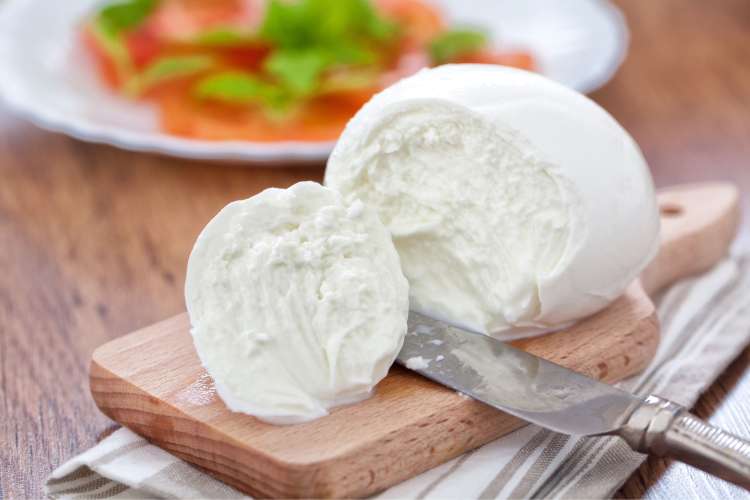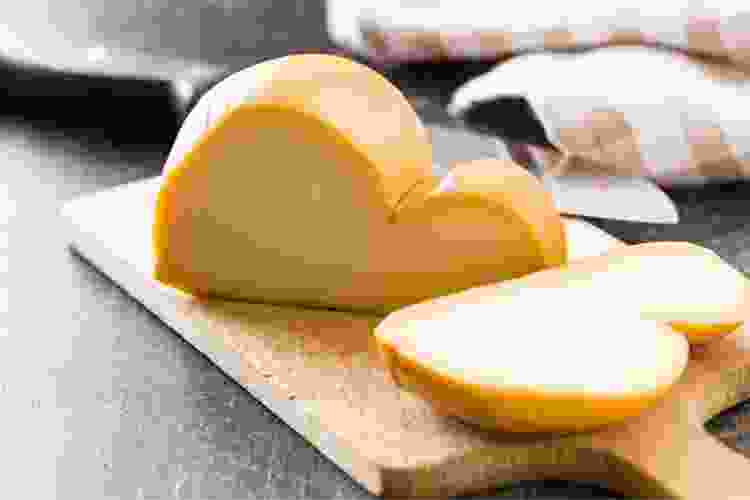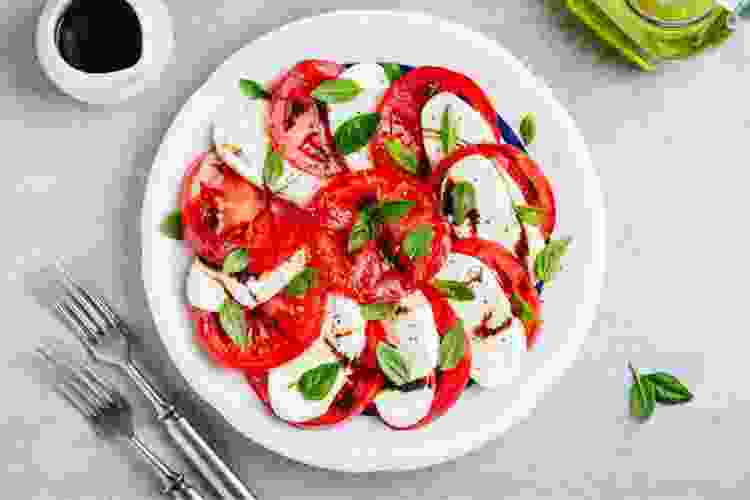Mozzarella Cheese in 2025 Isn’t Just for Pizza Anymore

Mozzarella cheese. Two words you can practically taste the moment you say them. Soft, stretchy and irresistibly creamy, mozzarella isn’t just cheese — it’s an experience. And despite what most people think, mozzarella doesn’t begin and end with pizza. It’s just as good cold, torn into salads or melted into something unexpected.
Jump to Section
- What Is Mozzarella Cheese?
- Where Mozzarella Comes From (and How It’s Made)
- Mozzarella Cheese Taste and Texture
- Types of Mozzarella Cheese
- Mozzarella and Pizza: A Perfect Match
- How to Use Mozzarella Cheese
- Health Benefits of Mozzarella Cheese
- Where to Buy Mozzarella Cheese
- How to Make Mozzarella Cheese at Home
- Mozzarella Cheese FAQs
What Is Mozzarella Cheese?

Mozzarella cheese is a semi-soft Italian cheese made with the pasta filata, or stretched-curd method. It was originally made in the Campania region in Italy and made with water buffalo milk — the kind known as mozzarella di bufala campana.
These days, most mozzarella is made from cow’s milk and is known as fior di latte. Both versions are creamy, mild and melt like a dream, which makes it a favorite for pizza-making.
Where Mozzarella Comes From (and How It’s Made)

Mozzarella has its roots in southern Italy, most likely in the Campania region, where water buffalo were introduced centuries ago. The exact origin is up for debate, but there are a few theories that still get tossed around.
Some say mozzarella evolved from a stretched-curd cheese called Provatùra believed to date back to the 7th century. Others credit monks from the San Lorenzo monastery in the 12th century, who are said to have first made the cheese using buffalo milk. Wherever the truth lies, two things are clear: the original version came from Campania and it was made with buffalo milk — rich, tangy and full of character.
Modern mozzarella is made with either buffalo or cow’s milk and follows a traditional technique called pasta filata, meaning “spun paste.” The milk is heated, cultured and curdled until it separates into curds and whey. Those curds are cut, gently cooked and then stretched and folded by hand (or machine) in hot water or whey until they become smooth and elastic. This is what gives mozzarella its signature stretch.
Once it reaches the right texture, the mozzarella is shaped — usually into balls — and cooled. Some versions are packed in brine, while others are vacuum-sealed, but the best mozzarella is eaten fresh, when the flavor is milky and the texture still soft and yielding.
Mozzarella Cheese Taste and Texture

Mozzarella has a mild, milky flavor that’s creamy and delicate when fresh. It’s not sharp or overpowering like aged cheese, which makes it incredibly versatile in the kitchen. The subtle flavor doesn't overpower other ingredients, but adds richness instead.
Its texture depends on the type. Fresh mozzarella is soft, smooth and moist, while melted mozzarella turns gooey and stretchy — exactly what you want in a slice of pizza or a hot sandwich.
Types of Mozzarella Cheese
Mozzarella can vary depending on how it’s made and the type of milk used.
1. Fresh Mozzarella

Soft, moist and creamy, fresh mozzarella is usually sold in balls (called ovoline) or smaller pearls (ciliegine), packed in water or whey. It’s best used in dishes like caprese salad, antipasti or simply eaten on its own with a little olive oil and salt.
2. Low-Moisture Mozzarella
Firmer and drier than the fresh kind, low-moisture mozzarella (commonly known as industrial mozzarella) is what you’ll often see shredded or sliced at the store. It melts well, lasts longer and has a slightly saltier, more concentrated flavor — perfect for pizza, lasagna and casseroles. Amul mozzarella is a well-known brand designed specifically for cooking.
3. Smoked Mozzarella

Also called Mozzarella Affumicata, this semi-soft, slightly elastic variety gets its flavor from being smoked over wood chips like hickory or chestnut. It’s savory, a little smoky and great on gourmet pizzas, in sandwiches or added to charcuterie board ideas.
4. Burrata
At first glance, burrata cheese may seem like a regular mozzarella ball until you slice it open and you’ll find a creamy, rich filling of stracciatella and cream. Burrata is best paired with simple ingredients — think fresh bread, olive oil and flaky salt.
5. Scamorza
Made the same way as mozzarella but aged and dried, scamorza is pear-shaped, firmer and less watery. It melts beautifully and holds its shape, making it great for baking or pan-frying.
6. Mozzarella di Bufala

Made from water buffalo milk, mozzarella di bufala has a tangier, more robust flavor than cow’s milk versions. It’s creamier, often softer and carries a PDO label — meaning it’s only produced in select regions of southern Italy like Campania.
Mozzarella and Pizza: A Perfect Match

The earliest pizzas — like the flatbreads once eaten in Naples — didn’t include cheese at all. That changed fast once new ingredients entered the scene and mozzarella quickly became the go-to.
So why does it work so well? First, there’s the flavor. Mozzarella’s mild, milky taste works well with everything, whether you’re sticking to the classics or piling on bold toppings (even pineapple, if that’s your thing).
Then there’s the melt. Few cheeses pull like mozzarella. It bubbles, stretches and browns just enough to give pizza that golden, gooey finish without overwhelming the crust or other toppings.
How to Use Mozzarella Cheese
Pizza might be its most iconic role, but mozzarella has range. It holds its own in fresh summer salads, comfort food casseroles and appetizers that disappear fast. The creamy flavor and perfect melt make it a go-to in all kinds of dishes.
1. Caprese Salad

Caprese is simple, fresh and a perfect way to enjoy mozzarella in its purest form. All you need are mozzarella balls, ripe tomatoes, basil, olive oil and a drizzle of balsamic.
2. Mozzarella Sticks
Mozzarella sticks are one of the most delicious and easiest appetizers to make. They’re crunchy on the outside and have the signature cheese pull that makes them addictive. Serve with marinara or spicy mayo for extra flavor.
3. Peach and Mozzarella Salad

For a sweet-savory mix, try pairing grilled peaches with mozzarella, basil, candied almonds and a drizzle of balsamic. Burrata works beautifully here, too.
4. Classic Lasagna
Layered between pasta sheets or sprinkled on top for a golden finish, mozzarella gives lasagna its signature stretch and comforting richness.
5. Melon Prosciutto Skewers

Skewer cantaloupe or honeydew, prosciutto and mozzarella balls for a refreshing bite with a perfect balance of salty and sweet. Serve with a sprinkle of fresh mint for a little extra flavor.
6. Grilled Mozzarella Sandwiches
Buttery bread, melty mozzarella — not much else needed. You can use slices of fresh or low-moisture mozzarella that melt perfectly, creating that signature cheese pull with every bite.
7. Calzone

Mozzarella cheese is a folded pizza’s best friend. It melts right into the ricotta and fillings, then bubbles up golden and gooey once baked — no slice required.
8. Cheese Board
When looking for cheese board ideas, it’s all about contrast. Mozzarella adds a soft, creamy element that pairs nicely with bolder cheeses like blue or gorgonzola. Try it with salty cured meats, briny olives or a drizzle of honey to round things out.
9. Cheesy Casserole

Chop whatever’s in your fridge, mix it with some protein, cover it in mozzarella and bake. Even picky eaters won’t complain — it’s hearty, comforting and couldn’t be easier. You can also use a mozzarella cheese substitute like Provolone or Gruyère.
If you want to try your hand at more mozzarella-based dishes, check out cooking classes in NYC and Toronto to Napa and everywhere in between.
Health Benefits of Mozzarella Cheese
Mozzarella isn’t just delicious — it’s surprisingly good for you too. It’s one of those rare ingredients that hits the comfort-food craving while still offering some real nutritional value.
High in Protein
Each 28-gram serving of full-fat mozzarella packs around six grams of protein, which is about the same as an ounce of cooked meat. It helps with everything from staying full to muscle repair.
Good Source of Calcium and Phosphorus
Mozzarella contains key minerals like calcium and phosphorus that support strong bones, healthy teeth and muscle function.
Low in Carbs
With only about 1 gram of carbs per ounce, mozzarella fits easily into low-carb and keto diets. It’s also satisfying enough to help you feel full, which makes it a smart snack or topping when you're trying to cut back without feeling like you're missing out.
Provides Vitamins
Mozzarella cheese provides small amounts of vitamin A, D and B12, which support the immune system, vision and nerve function.
Easily Digestible
Some types of mozzarella contain live cultures like Lactobacillus casei and Lactobacillus fermentum, which are linked to gut and immune health. It’s not a probiotic miracle, but it’s a tasty way to support digestion without thinking too hard about it.
Where to Buy Mozzarella Cheese

Where you buy mozzarella cheese depends on the type you want. Low-moisture mozzarella and mozzarella balls are easy to find at most supermarkets. Popular brands include Galbani, mozzarella cheese by Amul or Belgioioso.
If you’re looking for mozzarella di bufala or fresh mozzarella, check local delis or farmers' markets. They're more likely to stock smaller-batch or artisanal versions.
Prices vary depending on the type. Fresh mozzarella cheese packed in brine usually costs more than pre-shredded or block options, but the texture and flavor are worth it.
How to Make Mozzarella Cheese at Home

Yes, you can actually make mozzarella at home — and it’s easier than you might think. All it takes is some milk, citric acid, rennet and salt.
Start by warming a gallon of whole milk with citric acid, then add rennet to help it curdle. Once curds form, you’ll gently cut them and heat the mixture again to help them firm up. Scoop the curds into a bowl, drain off the whey and get ready for the fun part — stretching.
Heat the curds (either in hot whey or briefly in the microwave), then knead and stretch them until glossy and smooth. Shape into a ball, chill in cool water and enjoy.
It might not be as perfect as the store-bought stuff on your first try, but it’s pretty satisfying to say you made your own cheese.
Mozzarella Cheese FAQs
Is Mozzarella Cheese Healthy To Eat?

Yes, mozzarella is one of the lighter cheeses. It's high in protein, calcium and probiotics, with less fat and sodium than many other types of cheese.
Why Is Fresh Mozzarella So Expensive?
The price of mozzarella cheese depends on the type you buy. Fresh mozzarella tends to cost more because of its higher moisture content, shorter shelf life and traditional methods, often involving high-quality milk like buffalo or organic cow’s milk.
Is Mozzarella Made From Goat’s Milk?
Traditionally, mozzarella is made from cow’s or buffalo milk. Goat milk versions exist, but they’re much less common.
Is Mozzarella Cheese Healthier Than Cheddar?
Yes — mozzarella usually has less fat, calories and sodium than cheddar, so it’s a good pick if you're keeping things lighter.
Mozzarella might be famous for pizza, but that’s just the start. With so many styles and ways to use it, this cheese has more range than it gets credit for.
For even more fun foodie ideas, check out other experiences happening on Classpop!

